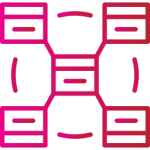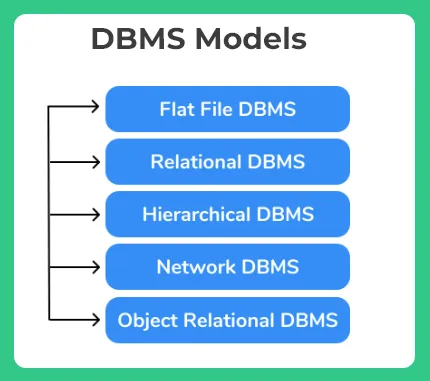DBMS Database Models
DBMS Models
On this page, we will learn about DBMS Database Models.Data model: Data model shows how data is represented in the conceptual level of the database architecture.

DBMS Database Models
In the history of database design, 5 database models have been used.
Flat file DBMS
- The file management system was the first method used to store data in the computer is a database
- Each data item is stored on a disc sequentially in one large file
- If you want to locate a particular item the search start from the beginning and each item is checked one by one sequentially till the match is found.
Drawbacks
Data duplication, very poor security, retrieving of data is very slow, no support for data, types dynamic memory allocation, concurrent data sharing is not allowed, no security mechanism through passwords, etc.

Relational DBMS
- It was first outlined by EF.codd 1970
The 2 components of the relational model are:
-
- collection of objects or relations that stores the data
- operations that can act on relations to produce other relations
This is the most frequent and commonly database today
Data integrity, logical representation in the form of table rows and columns, no data redundancy, logical links between relations are maintained, null, values integrity constraint, provides high security, unlimited size, security, range of data types, multiple users can work at a time
Hierarchical DBMS
- organize data like a tree structure, record types are the same as a relational data model
- The hierarchical data model is implemented based on one too many relations between parent and child records
- Because of a parent, child records in one-many relation many child records have single parent records as a result of repetition of child records occur
Network DBMS
- in 1970s CODASY(conference on data system language) committee introduced a network data model
- in this data, the model will maintain less duplicate data because their parent-child records are implemented based on many-many relation
- In this model also data is represented in the format of records and also record type is the same as a table in relation format
Object-relational DBMS
- In this model relational database but within object-oriented database design
- Object, class, inheritance is directly supported In database schema and the query language
- It provides a middle ground between the relational database and object-oriented database
- are OOPS is added to the relational database design productivity, security boosts a lot
Read more about Database here on this page.
Prime Course Trailer
Related Banners
Get PrepInsta Prime & get Access to all 200+ courses offered by PrepInsta in One Subscription
Get over 200+ course One Subscription
Courses like AI/ML, Cloud Computing, Ethical Hacking, C, C++, Java, Python, DSA (All Languages), Competitive Coding (All Languages), TCS, Infosys, Wipro, Amazon, DBMS, SQL and others






Login/Signup to comment